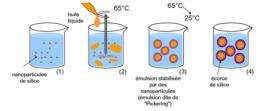Smart capsules that release their contents at a selected temperature

How can an active principle be delivered in a controlled way? Until now, there was no obvious answer to this question.
Now however, French researchers at the CNRS Paul Pascal Research Center in Bordeaux have designed smart capsules that are able to release their contents on demand, simply by raising the temperature. Described in an article published on 2 February 2010 in the journal Langmuir, this novel system has just been patented. It opens up the way to many applications in a large number of fields such as food, perfumes and agriculture, for instance to deliver pesticides above a specific temperature.
In order to deliver an encapsulated substance, such as a therapeutic agent in medicine, silica substrates are often used. Release then takes place via the pores in the silica or by dissolution of the latter, but this occurs in an uncontrolled, or practically uncontrolled, manner. To overcome this major disadvantage, three researchers from the Paul Pascal Research Center, one of CNRS's own units, have developed an ingenious and totally novel method: capsules that can release their contents on demand, under the effect of heating.
The idea is simple, and the system is easy to produce. The scientists disperse oil, which can contain a specific agent, in water. Stabilized in the form of droplets by silica particles, the emulsion's distinctive characteristic is that it is made up of oil that is liquid at the production temperature (65 °C), but solid at ambient temperature. A silica shell is then polymerized around the cooled droplets, and stable capsules that can be stored are obtained. It is then possible to trigger the release of the contents of the capsules by warming them to above the melting temperature of the selected oil. The transition from the solid state to the liquid state leads to expansion of the confined oil, which is enough to break the silica shell.
Any release temperature between 35°C and 56°C can easily be selected by choosing the appropriate oil or by mixing several types of oil. This temperature corresponds to the melting temperature of the oil or of the mixture of oils. Another parameter can be adjusted: the way in which the contents are released, either as strings of droplets, or all at once, which enables the rate of release of the contents to be controlled.

The principle is very simple, cheap, and applicable to a very large number of systems. The method could for instance be used to control freshness of foods or to release a perfume into the air, onto fabric or onto skin. Another possibility is the release of a therapeutic agent onto the skin, which in this case could be triggered locally by rubbing when it is applied (rubbing would cause warming). Another example would be the release of a bactericide when the temperature reaches that at which bacteria proliferate in air ducts. There are a great number of possible applications, and the researchers are already busy designing double emulsion systems that could be used to extend the technique to multitherapy.
More information: Thermo-stimulabled wax@SiO2 core shell particles. Mathieu Destribats, Véronique Schmitt et Rénal Backov. Langmuir. 2 February 2010
Provided by CNRS

















